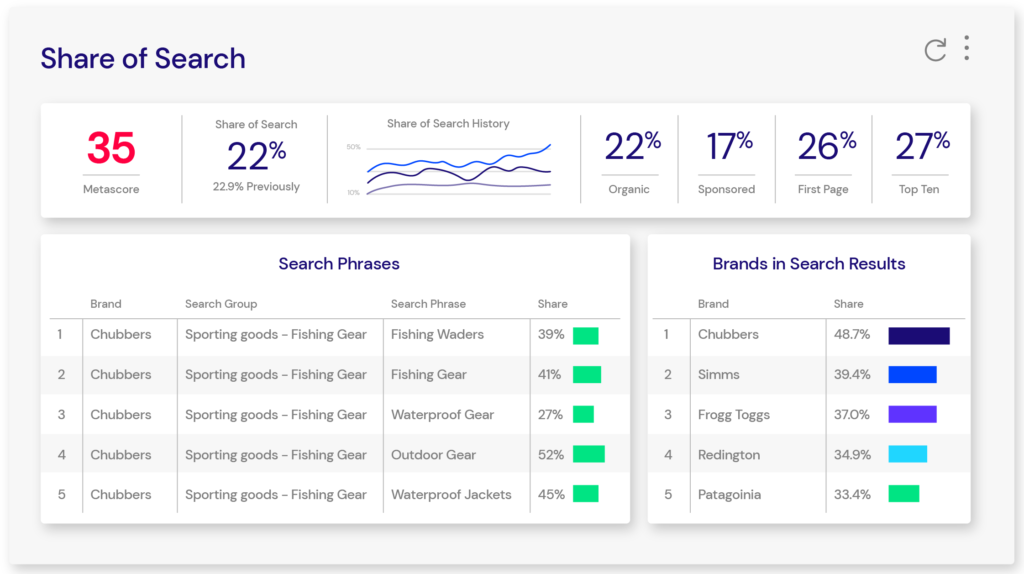Know thy self; know thy enemy. That’s Sun Tzu from The Art of War. Far be it from us to get all dramatic, but he’s got a point. If you want to stand a chance against your competitors, it’s wise to know where you stand versus where they stand. But there is no actual battlefield online — unless you’re playing Call of Duty, but that’s a whole other matter. Ecommerce is fought in the trenches of the digital shelf. And as Mr. Tzu would attest, there is no better weapon than being able to see what other brands are doing right and what they’re doing wrong, and adjusting your strategy accordingly.
The keys to digital shelf analytics are knowing what data to collect, getting the tools to collect it, and understanding what you can do with it. One of the main digital shelf metrics your brand needs to analyze is “share of search.” This metric shows you exactly how you stack up against the competition on each retailer’s site.
When consumers search for your product category, what brands do they find? How often do your product pages show up? What terms are most valuable to your business?
Your share of search helps answer questions like these. And when you can see your share of search on each retailer’s site, you gain valuable insights into what you can do to improve your performance. Sometimes you’ll discover immediate opportunities that require fast action. You might learn that you need to have a conversation with a retail partner. Or there may be a problem you need to investigate.
Here are five things you can learn from your share of search.
1. There are better ways to spend your ad budget
With just about any search term on a major retailer’s site, some of the results will be organic, and others sponsored. Sponsored searches are an excellent tactic to put your brand in front of the right people, but they’re most valuable to the brands that don’t naturally show up at the top of the results.
Mature brands with popular products and optimized product pages are most likely to organically appear on the first page of their product categories. But it’s fairly common for brands to appear in paid results and organic results. And that’s not a very good use of your ad spend.
Some terms and phrases are obviously more valuable than others. But if you’re earning free impressions for the most beneficial terms in your category, paying for a second slot on the results page probably isn’t as useful as paying for your first slot on another term.
Sponsored results tend to get less attention than organic ones (especially if customers can easily tell which result is an ad), but they’re much better than not showing up at all. And if your competitors are getting sales from a term your products don’t rank for, that’s a term you should go after. Your organic results will hold down the fort for those other terms.
2. Your retail partner’s algorithm is broken
When your products don’t rank for the terms you expect them to, it’s not always your fault. At PriceSpider, we’ve found that sometimes the problem is actually with a retailer’s search engine. It’s not uncommon for search engines to misunderstand what customers are searching for, so they serve up results from the wrong product category.
How do you know this is the case? If you rank well for a keyword on most retailers’ sites but don’t show up at all on another, that’s a sign there’s something different happening there. The big giveaway, however, is if none of your competitors show up for that term either.
Your retail partners will probably want to correct this quickly. Sales aren’t the only thing at stake. It makes them look bad, too, because their customers will either feel like “this store doesn’t understand what I need” or “this store doesn’t have what I need.”
3. Your competitors are better optimized for your category
Optimization isn’t the only factor that determines how well your products rank. People naturally click on brands they recognize, so brand awareness is important as well. If a product sells well and a search engine understands how to categorize it, it will probably rank for relevant terms, too. Customer reviews have an impact as well.
But if your products don’t show up in results for the terms you want to rank for, it’s usually a sign that your competitors are better optimized for it. Compare the first page of results to your own product page. What’s missing? How often are your competitors using the term in their descriptions and product page features? Is it in the title?
When you aren’t getting the share of search you want, it’s time to play “spot the differences” with your competitors.
4. Your products rank better with certain retailers
Even if your product page assets are identical from seller to seller, your pages are naturally going to perform differently in those separate environments. You’ll be up against some different competitors, and customers may not interact the same ways with your page. Not to mention, each retailer has a distinct search engine with its own algorithm.
When your product page doesn’t perform as well on a particular retailer’s site, it might be worth creating a unique version of your page for this retailer, based on what already ranks well. You may also want to consider putting more effort into driving reviews to this channel, perhaps even guiding customers to talk about specific aspects of their experience that could help you rank.
5. Which keywords competitors are investing in
With Brand Monitor, exploring your share of search doesn’t just reveal how your pages perform. It also shows which competitors are showing up in paid search for specific keywords. This helps you identify which phrases your competitors believe are most worth pursuing. Are they coming after keywords you currently rank for? Are they a threat? Have they found an opportunity you’ve overlooked?
Share of search is a valuable metric. And if you want to win the digital shelf, you need to investigate your competitors’ share of search as well as your own.
Start monitoring share of search
PriceSpider’s Brand Monitor gives you deep visibility into the digital shelf and helps you explore your share of search. Wherever your products appear, our specialized brand monitoring software equips you to evaluate how they’re performing compared to your competitors.
Want to see Brand Monitor’s share of search capabilities in action?


